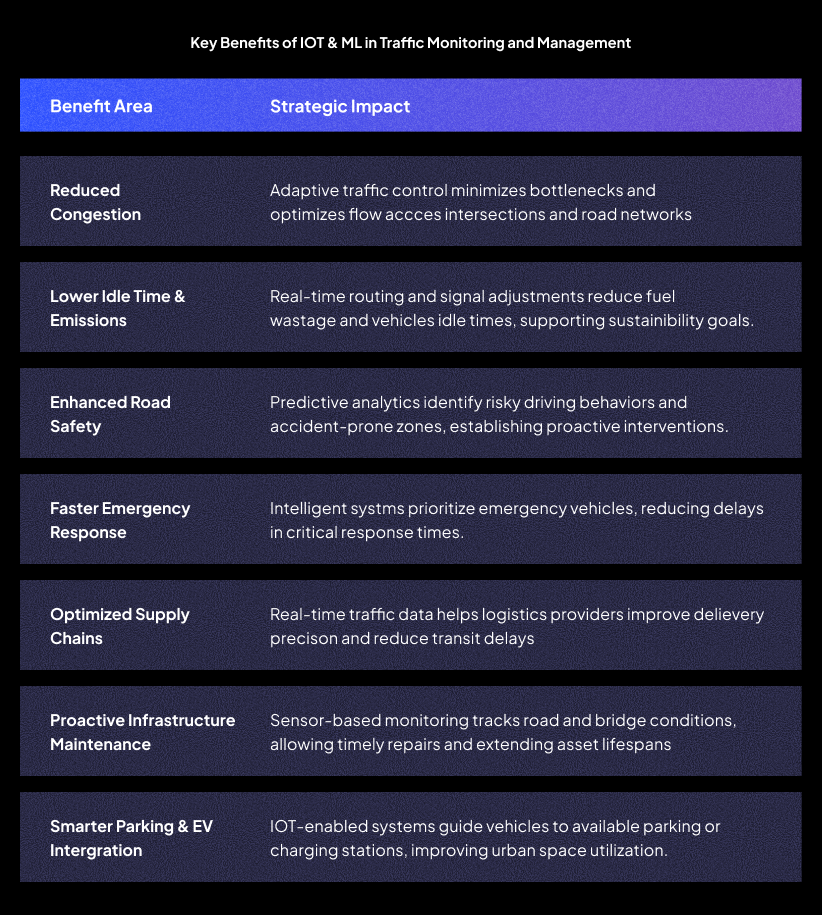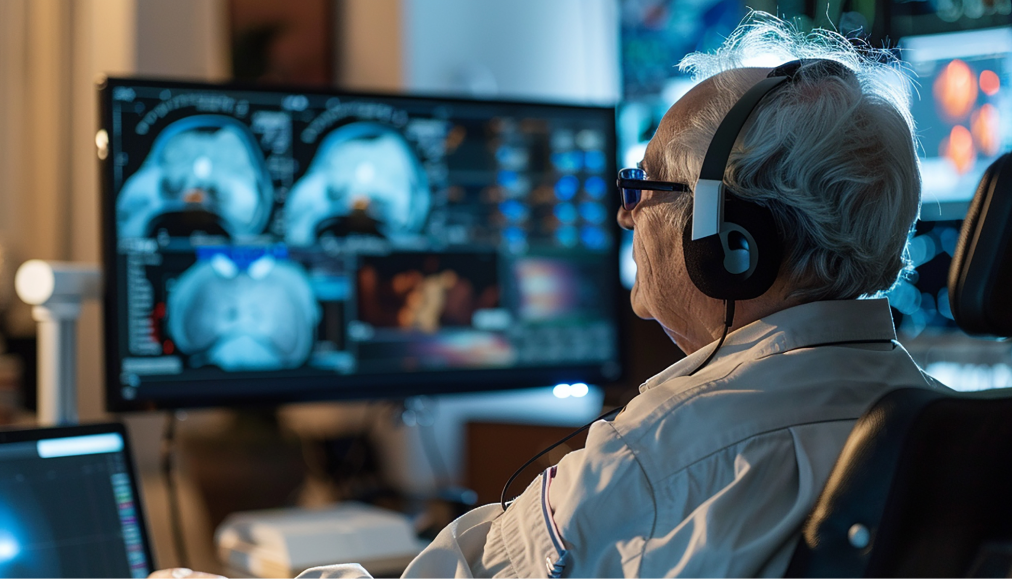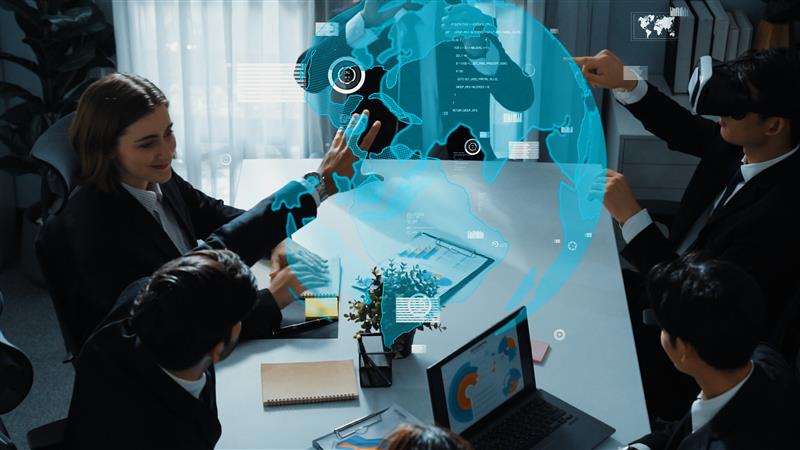The Role of IoT & Machine Learning in Traffic Monitoring and Management: Driving Smarter Cities and Industries
Urban congestion is no longer just a nuisance—it’s a global economic and environmental concern. As cities grow in population, traffic inefficiencies ripple across key industries, including logistics, healthcare, and manufacturing. IoT and Machine Learning (ML) aren’t futuristic buzzwords—they’ve become essential tools for managing this complex mobility puzzle.
Urbanization’s Rising Tide
Today, approximately 55% of the world’s population lives in urban areas. By 2050, that number is expected to surge to approximately 68%, according to the United Nations. That represents an influx of nearly 2.5 billion new urban dwellers. Likewise, the World Bank projects that almost 70% of the global population—almost 7 in 10 people—will reside in cities by mid-century.
This rapid urban growth brings increased demand for transportation, energy, and infrastructure. Cities currently consume up to 80% of global energy and produce 75% of carbon emissions, while occupying just 3% of land area. Without intelligent systems, urban mobility threatens to undermine productivity, public health, and climate goals.
Why IoT + ML Is Not Optional
Traditional traffic systems—relying on fixed-timing signals and delayed analytics—are failing under modern demands. Fortunately, IoT-ML platforms offer:
- Real-time data from embedded sensors, GPS, and cameras
- Dynamic ML models that adapt to traffic conditions
- Adaptive signal systems that optimize flow
- Predictive capacity to anticipate congestion and incidents
- Cross-sector insights benefitting logistics, healthcare, and manufacturing
Together, these systems don’t just ease commutes—they turbocharge economic efficiency.
How It Works: The Intelligent Traffic Lifecycle
1. IoT Data Collection
Cities deploy senors (road-embedded, vehicle-based, camera, and streetlight-integrated) to measure flow, speed, occupancy, lighting efficiency, and incident detection. IoT networks aggregate live data at central or edge-based repositories.
2. Machine Learning Insights
ML models process historical and streaming data to classify vehicle types, detect incidents, forecast congestion, and optimize signal timings. For example, a predictive framework reduced peak-hour congestion by 30% and improved flow by 20% in pilot zones.
3. Adaptive Control Systems
Dynamic traffic lights (such as SURTRAC in Pittsburgh) can reduce travel time by 25% and waiting time by 40%. These systems continually respond to shifting demand.
4. Cross-Industry Integration
Data-driven insights inform logistics routing, ambulance dispatch, manufacturing schedules, and infrastructure maintenance—all interconnected through a unified IoT backbone.
5. Digital Twin Modeling for Traffic Ecosystems
Digital Twins—virtual replicas of physical traffic infrastructure—enable continuous simulation of road networks, vehicle movement, and urban conditions. By integrating IoT sensor feeds and ML insights, cities can test different congestion scenarios, plan emergency reroutes, and simulate infrastructure changes before implementation. Think of it as a digital rehearsal for real-world mobility—minimizing risk, optimizing flow, and supporting proactive infrastructure decisions.
Global Innovation in Practice
1. Logistics & Supply Chain Optimization
- Real-time route recalculation reduces wait times and idle fuel consumption.
- Predictive analytics projects more reliable ETAs—vital for supply chains.
- Telematics over IoT enables driver behavior insights for risk management.
2. Emergency & Healthcare Mobility
- Green wave prioritization: Adaptive signals turn green as ambulances approach via GPS-enabled IoT telemetry.
- Stockholm’s traffic-priority system slashed EMS response times by ~40%.
3. Manufacturing & Industrial Connectivity
- Predictive insights sync logistics arrivals with production shifts.
- Employee commute patterns inform shift scheduling, avoiding bottlenecks.
- IoT supports integrated EV charging, measured through analytics pipelines.
Case Studies: Smart Traffic In Action
Pittsburgh’s SURTRAC
The Scalable Urban Traffic Control system, a Pittsburgh high-performance pilot, led to a 25% reduction in travel time and 40% fewer waits at intersections.
Meadowlands ASCT (New Jersey)
Serves 40 sq miles, linking 128 signals and managing over 400,000 vehicles daily, enhancing corridor efficiency across the region.
Ann Arbor, Michigan
Siemens-Imtech’s adaptive system cut travel time by 12% on weekdays and 21% on weekends.
Vizag & Tamil Nadu, India
- Vizag has launched adaptive AI traffic signals across major junctions to curtail peak-hour congestion.
- The Tambaram–Tindivanam highway now includes IoT-enabled streetlights and ambulance tracking via GPS sensors.

Enabling Technologies
1. Sensor Networks & Edge Computing
- Connected streetlights, CCTV, roadside units, and vehicle telematics feed data to local/edge servers.
- Edge processing minimizes latency, especially important for milliseconds-level signal control.
2. Machine Learning & Computer Vision
- Classification models trained on millions of images—by day/night/rain—determine vehicle types, count, and movements.
- Forecasting algorithms anticipate congestion before it happens.
3. Adaptive Traffic Signal Systems
- Examples: SURTRAC, InSync, MASSTR, CMU’s smart signals, AIoT Basha systems. These systems automatically adjust green/red phases based on real-time flow.
4. Predictive Analytics & Maintenance
- ML models detect road wear, weather impacts, and warn of potential hazards.
- Research in fog computing shows delay reduction for IoT traffic systems.
5. IoT Video Traffic Solutions
- Newer models use existing CCTV to analyze traffic density and phase signals accordingly, outperforming static systems by 34%.
Challenges and Considerations
1. Data Privacy & Security
- IoT systems collect sensitive data—GPS, video, behavioral metrics. Safeguards are mandatory.
2. Infrastructure Costs & Scalability
- Deployment of sensors, edge nodes, and signal controllers requires upfront investment, though often offset by long-term efficiency gains.
3. Interoperability & Standards
- Integrating legacy systems into new adaptive frameworks is critical for true end-to-end integration.
4. Continuous Calibration
- ML models must continuously learn as urban conditions evolve, requiring frequent retraining and feedback loops.
Technostacks’ Role in Intelligent Traffic Ecosystems
At Technostacks, we specialize in next-gen IoT-ML traffic solutions:
- High-performance vision models (Python/TensorFlow) trained on diverse datasets—classifying bicycles, cars, buses, and pedestrians across lighting and weather conditions.
- Real-time analytics pipelines, capturing and processing live streams for intersection-level decision-making.
- Edge-to-cloud orchestration enables real-time operations while also supporting long-term trend analysis.
- Custom dashboards provide city planners, logistics operators, and EMS dispatchers with actionable insights.
- Integration with EV infrastructure, linking charging station status to traffic flow predictions and routing.
Future Directions & Innovations
1. Vehicle-to-Infrastructure (V2I) Communication
- Traffic lights and vehicles exchange signal data mid-transit—minimizing stops, optimizing flow.
2. 5G & Low-Latency IoT
- High-speed networks will enable hyper-responsive control via edge AI.
3. Transport-as-a-Service (TaaS)
- Smart curb and parking management, dynamic ride-sharing, and real-time routing—integrated and optimized.
4. Multi-Modal Integration
- Seamless coordination across buses, bikes, pedestrians, rail, and micro-mobility services.
5. Proactive City Planning
- Infrastructure wear, accident risk, and mobility trends will drive optimized future expansions.
Read Our Case Study: IoT-Tracking Consumption of Water
Traffic is more than just vehicles on roads—it’s a pulse of economic flows, public health, and sustainability.
Companies that harness the transformative power of IoT + ML for traffic management will unlock agility, cost-efficiency, and smarter decision-making across logistics, healthcare, manufacturing, and civic operations.
Technostacks is ready to partner. Whether you’re piloting adaptive traffic lights, building a smart EMS routing system, or integrating your industrial fleet with city-wide mobility analytics, our solutions are built to scale with your ambition.
Connect with us to explore a smart, data-driven mobility roadmap—driven by real-world results, not promises.
FAQs
1. What is the role of IoT in traffic management systems?
IoT (Internet of Things) plays a critical role in traffic management by enabling real-time data collection through connected sensors, traffic cameras, and GPS-enabled devices. This data helps monitor vehicle flow, detect incidents, and optimize traffic signals, creating more efficient and responsive urban transportation systems.
2. How does machine learning improve urban traffic monitoring?
Machine Learning (ML) algorithms analyze real-time and historical traffic data to forecast congestion, identify patterns, and adapt signal timings dynamically. ML allows cities to implement predictive traffic management, reducing delays, accidents, and inefficiencies.
3. Why are smart traffic systems essential for smart cities?
Smart traffic systems form the backbone of smart cities, ensuring optimized vehicle movement, reduced emissions, and better public safety. They integrate IoT devices and AI technologies to make data-driven decisions that support sustainable urban development.
4. How can IoT and ML reduce traffic congestion in large cities?
IoT-enabled systems track real-time traffic density, while ML models process this data to dynamically adjust traffic light cycles and suggest alternative routes. Studies show congestion can be reduced by up to 30% using intelligent traffic signal systems.
5. What industries benefit from smart traffic management solutions?
Key industries benefiting from smart traffic solutions include logistics, healthcare, and manufacturing. Efficient routing reduces delivery times, ensures timely emergency response, and prevents production delays due to traffic-related absenteeism or supply chain disruption.
6. Can IoT in traffic systems help reduce carbon emissions?
Yes. By minimizing idle time and enabling real-time rerouting, IoT-based traffic systems significantly cut fuel consumption. This reduction directly lowers carbon emissions, supporting global climate goals and urban air quality improvement.
7. How does adaptive traffic signal control work using AI?
Adaptive signal control systems use real-time data from IoT sensors and feed it into AI/ML models. These models continuously adjust red and green light durations based on traffic volume and flow patterns, improving traffic throughput and reducing wait times.
8. What technologies power intelligent traffic management solutions?
Smart traffic solutions are powered by a combination of IoT sensors, edge computing, machine learning models, video analytics, and cloud dashboards. These systems work together to analyze and respond to traffic data with minimal human intervention.
9. What are the benefits of predictive traffic analytics?
Predictive analytics forecast traffic congestion, accidents, and infrastructure wear. Cities can act proactively to deploy resources, schedule maintenance, and issue alerts, leading to safer roads, lower costs, and faster response times.
10. How does Technostacks implement AI and IoT in traffic monitoring?
Technostacks builds end-to-end smart traffic systems using TensorFlow-based ML models, Python-powered analytics pipelines, and IoT integrations for real-time vehicle classification, congestion detection, and EV infrastructure syncing. Their solutions are tailored to scale across smart cities and industrial ecosystems.








